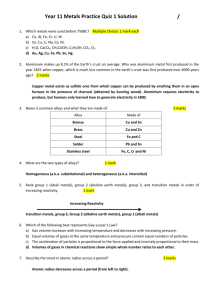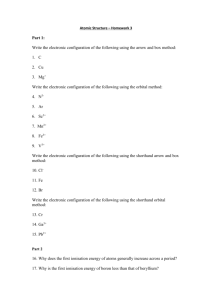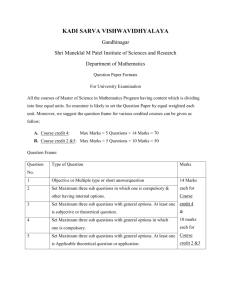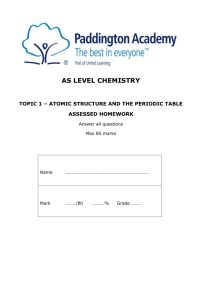Year 11 Metals Practice Quiz 1 Solution
advertisement
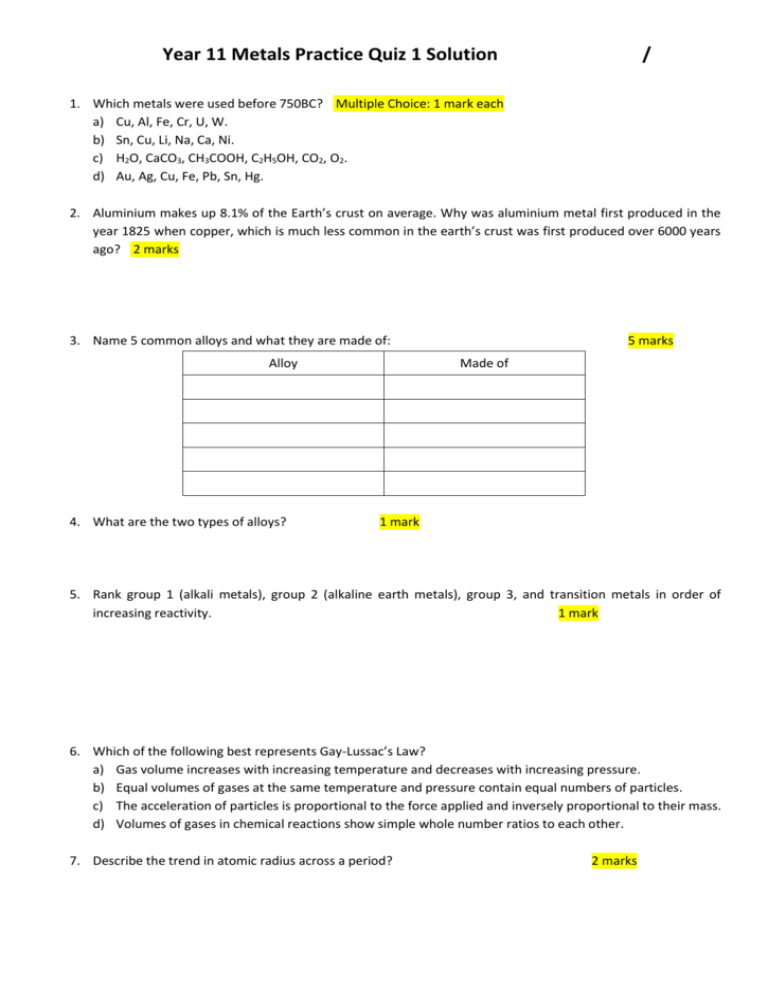
Year 11 Metals Practice Quiz 1 Solution / 1. Which metals were used before 750BC? Multiple Choice: 1 mark each a) Cu, Al, Fe, Cr, U, W. b) Sn, Cu, Li, Na, Ca, Ni. c) H2O, CaCO3, CH3COOH, C2H5OH, CO2, O2. d) Au, Ag, Cu, Fe, Pb, Sn, Hg. 2. Aluminium makes up 8.1% of the Earth’s crust on average. Why was aluminium metal first produced in the year 1825 when copper, which is much less common in the earth’s crust was first produced over 6000 years ago? 2 marks 3. Name 5 common alloys and what they are made of: Alloy 4. What are the two types of alloys? 5 marks Made of 1 mark 5. Rank group 1 (alkali metals), group 2 (alkaline earth metals), group 3, and transition metals in order of increasing reactivity. 1 mark 6. Which of the following best represents Gay-Lussac’s Law? a) Gas volume increases with increasing temperature and decreases with increasing pressure. b) Equal volumes of gases at the same temperature and pressure contain equal numbers of particles. c) The acceleration of particles is proportional to the force applied and inversely proportional to their mass. d) Volumes of gases in chemical reactions show simple whole number ratios to each other. 7. Describe the trend in atomic radius across a period? 2 marks 8. Explain why the atomic radius increases down the group. Moving down a group means: a) the atoms are getting heavier and therefore bigger. b) an extra electron shell is added. c) the number of electrons is increased, and between the electrons is a lot of empty space. d) the nucleus is more unstable and therefore more prone to swelling. 9. What are the trends for ionisation energy in the periodic table? a) Ionisation energy increases across groups and increases down periods. b) There are no trends in ionisation energy. It is totally random. c) The trend for ionisation energy is the opposite of the trend for electronegativity. d) Ionisation energy increases across periods and decreases down groups. 10. How did Dmitri Mendeleev arrange the elements in his periodic table? 2 marks 11. Chlorine-bromine-iodine, lithium-sodium-potassium, and sulphur-selenium-tellurium are three examples of Dobereiner’s triads. Give two properties of a Dobereiner triad. 1 mark 12. Which statement about ionisation energy is true? a) A big jump in ionisation energy indicates the element is a non-metal. b) The first ionisation energy of an element is always smallest. c) Hydrogen has the highest first ionisation energy of all the elements. d) The first ionisation of sodium is greater than the first ionisation energy of potassium. 13. What is Avogadro’s number? a) 6.022 x 1023. It was named in his honour because his work proved the relationship between the volume of a sample of gas and the number of particles in the gas. b) 6.022 x 1023. Avogadro proved that one mole of any substance contains 6.022 x 1023 particles. c) 6.022 x 1023. Avogadro proved that one gram of any substance contains 6.022 x 1023 particles. d) 6.022 x 1023. Avogadro proved that one ounce of any substance contains 6.022 x 1023 particles. 14. Rank calcium, phosphorous, fluorine in order of increasing atomic radius from smallest to largest. 15. Which of the following is a solubility rule? a) All chlorides are soluble. b) All ionic substances are soluble in water. c) Most sulfates are insoluble in water. d) Most sulfates are soluble in water. 3 marks 16. What is the volume of gas produced at 0°C and 100kPa when 1.000 kg of calcium carbonate is thermally decomposed? 3 marks 17. Which scientist is most associated with experimentally determining the atomic weights of elements? a) Albert Einstein. b) Galileo Galilei. c) John Dalton. d) James Watt. 18. How many moles are in 27g of water? a) Exactly 27 moles. b) 27 x Avogadro’s number of moles. c) Approximately 1.5 moles. d) The number of moles cannot be determined. 19. What is the molecular weight of ammonium nitrate? 2 marks 20. What is the mass of water formed when 19.832 litres of hydrogen is reacted with 37.185 litres of oxygen at 25°C and 100kPa? 3 marks 21. What volume of oxygen at 25°C and 100kPa would be required to completely combust 12 litres of cyclohexane vapour at 25°C and 100kPa? 2 marks 22. Which has the greatest number of atoms present, 47g of aluminium or 20g of glucose (C6H12O6)? 2 marks 23. What is meant by the empirical formula of a compound? 2 marks 24. A sample of a gaseous hydrocarbon (compound containing carbon and hydrogen only) was burnt in excess oxygen and yielded 338g of CO2 and 69g of H2O. What is the empirical formula of the hydrocarbon? 2 marks 25. What mass of fuel was burnt in the above question? 2 marks 26. What does smelting mean? a) Heating metal oxides with carbon to produce the metal. b) Recycling aluminium. c) Melting odorous compounds. d) Sunning. 27. How much energy does melting and recycling aluminium cans use compared to producing aluminium from its ore? a) 20%. b) 50%. c) 5%. d) 120%. 28. Which of the following are the main copper ores found in Australia? a) Haematite, rutile, boehmite, and magnetite. b) Uranite, cassiterite, ilemnite and bauxite. c) Galena, dolomite, pentlandite and sphalerite. d) Chalcopyrite, bornite, covellite, chalcocite, and cuprite. 29. What type of resource is petroleum? a) A renewable resource. b) A non-renewable resource. c) A fossil resource. d) A ductile resource 30. Which separation technique would be best for separating steel from scrap aluminium? a) Magnetic separation. b) Filtration. c) Froth flotation. d) Chromatography
